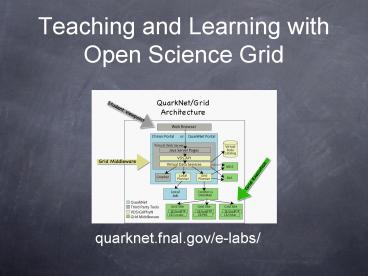Teaching and Learning with Open Science Grid - PowerPoint PPT Presentation
Title:
Teaching and Learning with Open Science Grid
Description:
Teaching and Learning with. Open Science Grid. quarknet.fnal.gov/e-labs/ Outline of Talk ... Uploading Data to the QuarkNet Portal using a Web Browser. 01000110101011 ... – PowerPoint PPT presentation
Number of Views:36
Avg rating:3.0/5.0
Title: Teaching and Learning with Open Science Grid
1
Teaching and Learning with Open Science Grid
quarknet.fnal.gov/e-labs/
2
Outline of Talk
- Introduction to QuarkNet/Grid
- Overview of the e-Lab
- Implementation
- Reusability
- Lessons Learned
3
QuarkNet
- The primary education program for US-ATLAS and
US-CMS, large scale experiments - Developing a research community of physicists,
high school teachers their students - Engaging teachers subsequently students in
scientific investigations
4
Goals of QuarkNet/Grid
- Students participate in a scientific
collaboration and make real contributions to a
scientific field. - Students use virtual data tools and techniques to
upload, access, process and publish data, report
their results as online poster, and have online
discussions about their work with peers. - Educational researchers evaluate the
effectiveness of such an endeavor. - Grid specialists explore interface designs that
enhance accessibility to Grid data and
computational resources.
5
Outline of Talk
- Introduction to QuarkNet/Grid
- Overview of the e-Lab
- Implementation
- Reusability
- Lessons Learned
6
Cosmic Ray Detectors (DAQS)in High Schools
7
Uploading Data to the QuarkNet Portal using a Web
Browser
8
Analyzing Data on the QuarkNet Portal using a Web
Browser
9
Using the Grid to Handle Calculations with Lots
of Data
10
Student Logbook
11
Sample Comments on Logbook
12
Publishing Posters
13
Outline of Talk
- Introduction to QuarkNet/Grid
- Overview of the e-Lab
- Implementation
- Reusability
- Lessons Learned
14
Design Basics for e-Lab
- Requires the GriPhyN Virtual Data System (VDS)
- Serves JavaServer Pages from Apache Tomcat
- Interfaces to local and Grid planners, such as
Euryale and Pegasus
15
Detailed Design
16
Transformations Derivations
- Transformations stitch together code into one
workflow for local or grid execution. - Derivations invoke transformations with specific
inputs, like a function call.
DV Quarknet.CosmicLifetimeStudygt anonymous( com
bineOutfile, 180, 2.3, 7, 1.73, 100.27)
TR Quarknet.CosmicLifetimeStudy( inout
combineOut, none detector, none
extraFun_alpha_guess, none extraFun_alpha_variate
, none extraFun_constant_guess, none
extraFun_constant_variate)
Transformation
Derivation
17
Provenance
- Provenance is the audit trail for the computation
of a data product. - Students collaborate by extending others
computations using provenance.
TR Quarknet.CosmicLifetimeStudy( inout
combineOut, none detector, none
extraFun_alpha_guess, none extraFun_alpha_variate
, none extraFun_constant_guess, none
extraFun_constant_variate)
Virtual Data Language
Provenance
18
Metadata
- Data about data
- Exist on transformations, files and virtual files
19
Outline of Talk
- Introduction to QuarkNet/Grid
- Overview of the e-Lab
- Implementation
- Reusability
- Lessons Learned
20
Reusability Rethinking Our Original Design
- QuarkNet/Grid started as a pilot program with
primary focus on a working model. - Now, we aim to support new e-Labs using the same
tools, look and feel, general architecture, etc. - CMS test beam data is a near-term goal.
21
Framework
Cosmic Ray e-Lab
CMS e-Lab
Analysis Code
Data
VDL Workflows
Content
Registration
22
Outline of Talk
- Introduction to QuarkNet/Grid
- Overview of the e-Lab
- Implementation
- Reusability
- Lessons Learned
23
We have users!
- 243 teachers
- 240 high schools
- 259 student research groups
- 104 analyses performed since May 2005
- 200 detectors in high schools (with CROP)
- 70 more detectors ready soon
24
We have lessons!
- Grid work is bleeding-edge and harder than it
looks. - Professional development for teachers is
critical. - Developers must work within technical constraints
of schools. - Its premature to understand how the Grid
enhances education.
25
Questions
- Introduction to QuarkNet/Grid
- Overview of the e-Lab
- Implementation
- Reusability
- Lessons Learned































